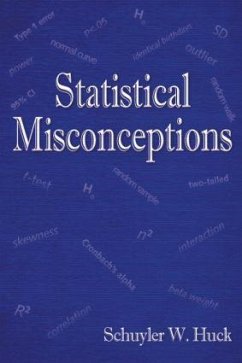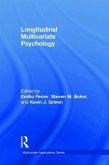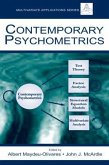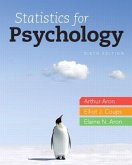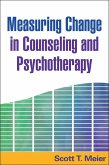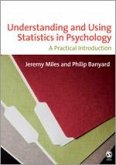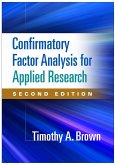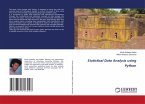Schuyler W Huck
Statistical Misconceptions
Schuyler W Huck
Statistical Misconceptions
- Gebundenes Buch
- Merkliste
- Auf die Merkliste
- Bewerten Bewerten
- Teilen
- Produkt teilen
- Produkterinnerung
- Produkterinnerung
First Published in 2009. Routledge is an imprint of Taylor & Francis, an informa company.
Andere Kunden interessierten sich auch für
![Longitudinal Multivariate Psychology Longitudinal Multivariate Psychology]() Longitudinal Multivariate Psychology198,99 €
Longitudinal Multivariate Psychology198,99 €![Contemporary Psychometrics Contemporary Psychometrics]() Contemporary Psychometrics198,99 €
Contemporary Psychometrics198,99 €![Statistics for Psychology Statistics for Psychology]() Arthur AronStatistics for Psychology337,99 €
Arthur AronStatistics for Psychology337,99 €![Measuring Change in Counseling and Psychotherapy Measuring Change in Counseling and Psychotherapy]() Scott T MeierMeasuring Change in Counseling and Psychotherapy67,99 €
Scott T MeierMeasuring Change in Counseling and Psychotherapy67,99 €![Understanding and Using Statistics in Psychology Understanding and Using Statistics in Psychology]() Jeremy MilesUnderstanding and Using Statistics in Psychology229,99 €
Jeremy MilesUnderstanding and Using Statistics in Psychology229,99 €![Confirmatory Factor Analysis for Applied Research Confirmatory Factor Analysis for Applied Research]() Timothy A BrownConfirmatory Factor Analysis for Applied Research130,99 €
Timothy A BrownConfirmatory Factor Analysis for Applied Research130,99 €![Statistical Data Analysis using Python Statistical Data Analysis using Python]() Kindu Kebede GebreStatistical Data Analysis using Python45,99 €
Kindu Kebede GebreStatistical Data Analysis using Python45,99 €-
-
-
First Published in 2009. Routledge is an imprint of Taylor & Francis, an informa company.
Hinweis: Dieser Artikel kann nur an eine deutsche Lieferadresse ausgeliefert werden.
Hinweis: Dieser Artikel kann nur an eine deutsche Lieferadresse ausgeliefert werden.
Produktdetails
- Produktdetails
- Verlag: Taylor & Francis
- Seitenzahl: 308
- Erscheinungstermin: 3. November 2008
- Englisch
- Abmessung: 229mm x 157mm x 18mm
- Gewicht: 544g
- ISBN-13: 9780805859027
- ISBN-10: 0805859020
- Artikelnr.: 25856598
- Herstellerkennzeichnung
- Libri GmbH
- Europaallee 1
- 36244 Bad Hersfeld
- gpsr@libri.de
- Verlag: Taylor & Francis
- Seitenzahl: 308
- Erscheinungstermin: 3. November 2008
- Englisch
- Abmessung: 229mm x 157mm x 18mm
- Gewicht: 544g
- ISBN-13: 9780805859027
- ISBN-10: 0805859020
- Artikelnr.: 25856598
- Herstellerkennzeichnung
- Libri GmbH
- Europaallee 1
- 36244 Bad Hersfeld
- gpsr@libri.de
Schuyler W. Huck is a Professor of Educational Psychology at the University of Tennessee - Knoxville. He received his Ph.D. from Northwestern University. A former President of AERA's Educational Statisticians SIG, in 2004 he was elected to Chair AERA's SIG Executive Committee and a member of AERA's governing board. His previously published books include Reading Statistics & Research, 4/e (A&B) 2004, Statistical Illusions (HC) 1983, & Rival Hypotheses (Harper) 1979.
Part 1. Descriptive Statistics. 1.1. Measures of Central Tendency. 1.2. The
Mean of Means. 1.3. The Mode's Location. 1.4. The Standard Deviation. Part
2. Distributional Shape. 2.1. The Shape of the Normal Curve. 2.2. Skewed
Distributions and Measures of Central Tendency. 2.3. Standard Scores and
Normality. 2.4. Rectangular Distributions and Kurtosis. Part 3. Bivariate
Correlation. 3.1. Correlation Coefficients. 3.2. Correlation and Causality.
3.3. The Effect of a Single Outlier on Pearson's r. 3.4. Relationship
Strength and r. 3.5. The Meaning of r = 0. Part 4. Reliability and
Validity. 4.1. Statistical Indices of Reliability and Validity. 4.2.
Interrater Reliability. 4.3. Cronbach's Alpha and Unidimensionality. 4.4.
Range Restriction and Predictive Validity. Part 5. Probability. 5.1. The
Binomial Distribution and N. 5.2. A Random Walk With a Perfectly Fair Coin.
5.3. Two Goats and a Car. 5.4. Identical Birthdays. 5.5. The Sum of an
Infinite Number of Numbers. 5.6.Being Diagnosed With a Rare Disease. 5.7.
Risk Ratios and Odds Ratios. Part 6. Sampling. 6.1.The Character of Random
Samples. 6.2. Random Replacements When Sampling. 6.3Precision and the
Sampling Fraction. 6.4. Matched Samples. 6.5. Finite Versus Infinite
Populations. Part 7. Estimation. 7.1. Interpreting a Confidence Interval.
7.2. Overlapping Confidence Intervals. 7.3. The Mean ± the Standard Error.
7.4. Confidence Intervals and Replication. Part 8. Hypothesis Testing.
8.1. Alpha and Type I Error Risk. 8.2. The Null Hypothesis. 8.3.Disproving
Ho. 8.4. The Meaning of p. 8.5. Directionality and Tails. 8.6. The
Relationship Between Alpha and Beta Errors. Part 9. t-Tests Involving One
or Two Means. 9.1.Correlated t-Tests. 9.2. The Difference Between Two Means
If p < .00001. 9.3. The Robustness of a t-Test When n1 = n2. Part 10. ANOVA
and ANCOVA. 10.1. Pairwise Comparisons. 10.2. The Cause of a Significant
Interaction. 10.3. Equal Covariate Means in ANCOVA. Part 11. Practical
Significance, Power, and Effect Size. 11.1. Statistical Significance Versus
Practical Significance. 11.2. A Priori and Post Hoc Power. 11.3. Eta
Squared and Partial Eta Squared. Part 12. Regression. 12.1. Comparing Two
rs; Comparing Two bs. 12.2. R2. 12.3. Predictor Variables that Are
Uncorrelated with Y. 12.4. Beta Weights.
Mean of Means. 1.3. The Mode's Location. 1.4. The Standard Deviation. Part
2. Distributional Shape. 2.1. The Shape of the Normal Curve. 2.2. Skewed
Distributions and Measures of Central Tendency. 2.3. Standard Scores and
Normality. 2.4. Rectangular Distributions and Kurtosis. Part 3. Bivariate
Correlation. 3.1. Correlation Coefficients. 3.2. Correlation and Causality.
3.3. The Effect of a Single Outlier on Pearson's r. 3.4. Relationship
Strength and r. 3.5. The Meaning of r = 0. Part 4. Reliability and
Validity. 4.1. Statistical Indices of Reliability and Validity. 4.2.
Interrater Reliability. 4.3. Cronbach's Alpha and Unidimensionality. 4.4.
Range Restriction and Predictive Validity. Part 5. Probability. 5.1. The
Binomial Distribution and N. 5.2. A Random Walk With a Perfectly Fair Coin.
5.3. Two Goats and a Car. 5.4. Identical Birthdays. 5.5. The Sum of an
Infinite Number of Numbers. 5.6.Being Diagnosed With a Rare Disease. 5.7.
Risk Ratios and Odds Ratios. Part 6. Sampling. 6.1.The Character of Random
Samples. 6.2. Random Replacements When Sampling. 6.3Precision and the
Sampling Fraction. 6.4. Matched Samples. 6.5. Finite Versus Infinite
Populations. Part 7. Estimation. 7.1. Interpreting a Confidence Interval.
7.2. Overlapping Confidence Intervals. 7.3. The Mean ± the Standard Error.
7.4. Confidence Intervals and Replication. Part 8. Hypothesis Testing.
8.1. Alpha and Type I Error Risk. 8.2. The Null Hypothesis. 8.3.Disproving
Ho. 8.4. The Meaning of p. 8.5. Directionality and Tails. 8.6. The
Relationship Between Alpha and Beta Errors. Part 9. t-Tests Involving One
or Two Means. 9.1.Correlated t-Tests. 9.2. The Difference Between Two Means
If p < .00001. 9.3. The Robustness of a t-Test When n1 = n2. Part 10. ANOVA
and ANCOVA. 10.1. Pairwise Comparisons. 10.2. The Cause of a Significant
Interaction. 10.3. Equal Covariate Means in ANCOVA. Part 11. Practical
Significance, Power, and Effect Size. 11.1. Statistical Significance Versus
Practical Significance. 11.2. A Priori and Post Hoc Power. 11.3. Eta
Squared and Partial Eta Squared. Part 12. Regression. 12.1. Comparing Two
rs; Comparing Two bs. 12.2. R2. 12.3. Predictor Variables that Are
Uncorrelated with Y. 12.4. Beta Weights.
Part 1. Descriptive Statistics. 1.1. Measures of Central Tendency. 1.2. The
Mean of Means. 1.3. The Mode's Location. 1.4. The Standard Deviation. Part
2. Distributional Shape. 2.1. The Shape of the Normal Curve. 2.2. Skewed
Distributions and Measures of Central Tendency. 2.3. Standard Scores and
Normality. 2.4. Rectangular Distributions and Kurtosis. Part 3. Bivariate
Correlation. 3.1. Correlation Coefficients. 3.2. Correlation and Causality.
3.3. The Effect of a Single Outlier on Pearson's r. 3.4. Relationship
Strength and r. 3.5. The Meaning of r = 0. Part 4. Reliability and
Validity. 4.1. Statistical Indices of Reliability and Validity. 4.2.
Interrater Reliability. 4.3. Cronbach's Alpha and Unidimensionality. 4.4.
Range Restriction and Predictive Validity. Part 5. Probability. 5.1. The
Binomial Distribution and N. 5.2. A Random Walk With a Perfectly Fair Coin.
5.3. Two Goats and a Car. 5.4. Identical Birthdays. 5.5. The Sum of an
Infinite Number of Numbers. 5.6.Being Diagnosed With a Rare Disease. 5.7.
Risk Ratios and Odds Ratios. Part 6. Sampling. 6.1.The Character of Random
Samples. 6.2. Random Replacements When Sampling. 6.3Precision and the
Sampling Fraction. 6.4. Matched Samples. 6.5. Finite Versus Infinite
Populations. Part 7. Estimation. 7.1. Interpreting a Confidence Interval.
7.2. Overlapping Confidence Intervals. 7.3. The Mean ± the Standard Error.
7.4. Confidence Intervals and Replication. Part 8. Hypothesis Testing.
8.1. Alpha and Type I Error Risk. 8.2. The Null Hypothesis. 8.3.Disproving
Ho. 8.4. The Meaning of p. 8.5. Directionality and Tails. 8.6. The
Relationship Between Alpha and Beta Errors. Part 9. t-Tests Involving One
or Two Means. 9.1.Correlated t-Tests. 9.2. The Difference Between Two Means
If p < .00001. 9.3. The Robustness of a t-Test When n1 = n2. Part 10. ANOVA
and ANCOVA. 10.1. Pairwise Comparisons. 10.2. The Cause of a Significant
Interaction. 10.3. Equal Covariate Means in ANCOVA. Part 11. Practical
Significance, Power, and Effect Size. 11.1. Statistical Significance Versus
Practical Significance. 11.2. A Priori and Post Hoc Power. 11.3. Eta
Squared and Partial Eta Squared. Part 12. Regression. 12.1. Comparing Two
rs; Comparing Two bs. 12.2. R2. 12.3. Predictor Variables that Are
Uncorrelated with Y. 12.4. Beta Weights.
Mean of Means. 1.3. The Mode's Location. 1.4. The Standard Deviation. Part
2. Distributional Shape. 2.1. The Shape of the Normal Curve. 2.2. Skewed
Distributions and Measures of Central Tendency. 2.3. Standard Scores and
Normality. 2.4. Rectangular Distributions and Kurtosis. Part 3. Bivariate
Correlation. 3.1. Correlation Coefficients. 3.2. Correlation and Causality.
3.3. The Effect of a Single Outlier on Pearson's r. 3.4. Relationship
Strength and r. 3.5. The Meaning of r = 0. Part 4. Reliability and
Validity. 4.1. Statistical Indices of Reliability and Validity. 4.2.
Interrater Reliability. 4.3. Cronbach's Alpha and Unidimensionality. 4.4.
Range Restriction and Predictive Validity. Part 5. Probability. 5.1. The
Binomial Distribution and N. 5.2. A Random Walk With a Perfectly Fair Coin.
5.3. Two Goats and a Car. 5.4. Identical Birthdays. 5.5. The Sum of an
Infinite Number of Numbers. 5.6.Being Diagnosed With a Rare Disease. 5.7.
Risk Ratios and Odds Ratios. Part 6. Sampling. 6.1.The Character of Random
Samples. 6.2. Random Replacements When Sampling. 6.3Precision and the
Sampling Fraction. 6.4. Matched Samples. 6.5. Finite Versus Infinite
Populations. Part 7. Estimation. 7.1. Interpreting a Confidence Interval.
7.2. Overlapping Confidence Intervals. 7.3. The Mean ± the Standard Error.
7.4. Confidence Intervals and Replication. Part 8. Hypothesis Testing.
8.1. Alpha and Type I Error Risk. 8.2. The Null Hypothesis. 8.3.Disproving
Ho. 8.4. The Meaning of p. 8.5. Directionality and Tails. 8.6. The
Relationship Between Alpha and Beta Errors. Part 9. t-Tests Involving One
or Two Means. 9.1.Correlated t-Tests. 9.2. The Difference Between Two Means
If p < .00001. 9.3. The Robustness of a t-Test When n1 = n2. Part 10. ANOVA
and ANCOVA. 10.1. Pairwise Comparisons. 10.2. The Cause of a Significant
Interaction. 10.3. Equal Covariate Means in ANCOVA. Part 11. Practical
Significance, Power, and Effect Size. 11.1. Statistical Significance Versus
Practical Significance. 11.2. A Priori and Post Hoc Power. 11.3. Eta
Squared and Partial Eta Squared. Part 12. Regression. 12.1. Comparing Two
rs; Comparing Two bs. 12.2. R2. 12.3. Predictor Variables that Are
Uncorrelated with Y. 12.4. Beta Weights.

